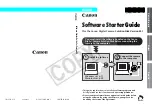
Authenticating Users
ExtremeWare XOS 11.3 Concepts Guide
351
Exclusions and Limitations
The following are limitations and exclusions for network login:
●
All unauthenticated MACs will be seeing broadcasts and multicasts sent to the port if even a single
MAC is authenticated on that port.
●
Network login must be disabled on a port before that port can be deleted from a VLAN.
●
In Campus mode on the BlackDiamond 8800 family of switches and the Summit X450 switch, with
untagged VLANs and the netlogin port’s mode configured as port-mode, after the port moves to the
destination VLAN, the original VLAN for that port is not displayed.
●
A network login VLAN port should not be a part of following protocols:
■
Ethernet Automatic Protection Switching (EAPS)
■
Extreme Standby Router Protocol (ESRP)
■
Spanning Tree Protocol (STP)
■
Link Aggregation
Authenticating Users
Network login uses two methods to authenticate users trying to access the network:
●
RADIUS servers
●
Local database
All three network login protocols, web-based, MAC-based, and 802.1x netlogin, support RADIUS
authentication. Only web-based and MAC-based netlogin support local database authentication.
This section describes the following topics in greater detail:
●
Creating User Accounts on the RADIUS Server on page 351
●
Configuring Local Database Authentication on page 355
Creating User Accounts on the RADIUS Server
You can create two types of user accounts on your RADIUS server for authenticating network login
users: netlogin-only enabled and netlogin-only disabled. A netlogin-only disabled user can log in using
network login and can also access the switch using Telnet or SSH. A netlogin-only enabled user can
only log in using network login and cannot access the switch using the same login.
NOTE
For information on how to use and configure your RADIUS server, please refer to the documentation that came with
your RADIUS server.
In the following example using FreeRADIUS, you add the configuration to the RADIUS server users
file. The users file determines which attributes are sent back by the RADIUS server to the RADIUS
client (an Extreme Networks switch). Depending on your RADIUS server, where and how you add the
configuration might be different.
Summary of Contents for ExtremeWare XOS 11.3
Page 20: ...Contents ExtremeWare XOS 11 3 Concepts Guide 20...
Page 25: ...1 Using ExtremeWare XOS...
Page 26: ......
Page 38: ...ExtremeWare XOS Overview ExtremeWare XOS 11 3 Concepts Guide 38...
Page 58: ...Accessing the Switch ExtremeWare XOS 11 3 Concepts Guide 58...
Page 146: ...Configuring Slots and Ports on a Switch ExtremeWare XOS 11 3 Concepts Guide 146...
Page 218: ...Status Monitoring and Statistics ExtremeWare XOS 11 3 Concepts Guide 218...
Page 240: ...Virtual LANs ExtremeWare XOS 11 3 Concepts Guide 240...
Page 248: ...Virtual Routers ExtremeWare XOS 11 3 Concepts Guide 248...
Page 278: ...Access Lists ACLs ExtremeWare XOS 11 3 Concepts Guide 278...
Page 288: ...Routing Policies ExtremeWare XOS 11 3 Concepts Guide 288 entry deny_rest if then deny...
Page 344: ...Security ExtremeWare XOS 11 3 Concepts Guide 344...
Page 393: ...2 Using Switching and Routing Protocols...
Page 394: ......
Page 454: ...Spanning Tree Protocol ExtremeWare XOS 11 3 Concepts Guide 454...
Page 484: ...Extreme Standby Router Protocol ExtremeWare XOS 11 3 Concepts Guide 484...
Page 514: ...IPv4 Unicast Routing ExtremeWare XOS 11 3 Concepts Guide 514...
Page 530: ...IPv6 Unicast Routing ExtremeWare XOS 11 3 Concepts Guide 530...
Page 538: ...RIP ExtremeWare XOS 11 3 Concepts Guide 538...
Page 556: ...OSPF ExtremeWare XOS 11 3 Concepts Guide 556...
Page 566: ...OSPFv3 ExtremeWare XOS 11 3 Concepts Guide 566...
Page 589: ...3 Appendixes...
Page 590: ......
Page 640: ...CNA Agent ExtremeWare XOS 11 3 Concepts Guide 640...
Page 670: ...Glossary ExtremeWare XOS 11 3 Concepts Guide 670...
Page 698: ...Index ExtremeWare XOS 11 3 Concepts Guide 698...
















































